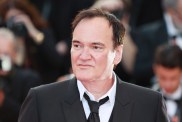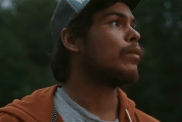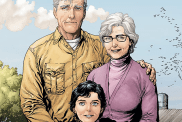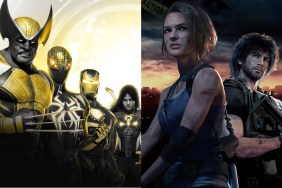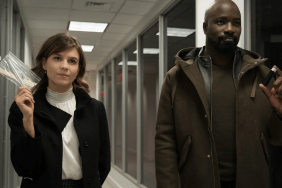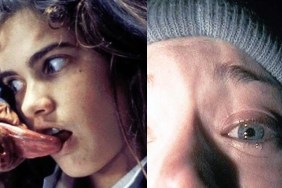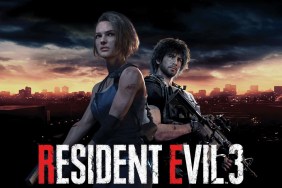Detailed report from Mexico City

Super Mario Brothers. Street Fighter. Wing Commander. Double Dragon. Alone in the Dark. The list of failed video game-to-film adaptations is long and includes titles that were at one time the most popular games in the world, but which nevertheless only attracted indifference (if not out and out scorn) from audiences and critics. “There’s just no love of the game, that’s what I think,” says Jeremy Bolt, producer of the “Resident Evil” franchise. “These filmmakers haven’t really understood why these people love these games.”
He’s strolling down the textured alleys of Estudios Churubusco in Mexico City, a mile above sea level and balmy even in the middle of July, seemingly relaxed and unhurried in his blue knitted shirt and cargo pants, while all around Mexican crew members race to finish sets, filling the air with the sound of hammers and table saws as Resident Evil: Extinction, the third (and possibly final, but more on that later) film in the “Resident Evil” series settles into its new home following six grueling weeks of filming in the desert outside Mexicali where temperatures routinely reached as high as 105 degrees.
Considering the long line of failures that preceded it, it’s a wonder the first “Resident Evil” survived at all, much less flourished. An exceptionally popular game from its inception in 1996, Japanese developers Capcom began trying to adapt it into a workable film almost immediately. In 1999, Capcom and Sony Pictures brought on esteemed zombie maestro George A. Romero to helm the adaptation, a filmic match made in heaven if ever there was one, but the motion picture business being what it is, the ambiguous and inevitable “creative differences” soon arose between Romero and the studio (hinging, ironically, on Romero’s script not being faithful enough to the game) and “Resident Evil” was quickly put in turnaround, by all rights never to return. Waiting in the wings, however, was Paul W.S. Anderson, fresh off a disaster of his own and looking for a clean start.
“We made a movie and it didn’t work,” Bolt recalls, “and [Paul] kind of went to ground for a year. He spent the whole year basically playing Resident Evil in the dark in his house in Santa Monica. I could never get him on the phone. But he spent a year playing this game non-stop. And he called me up, finally, and said ‘I’ve got an idea. We’re going to make Resident Evil into a movie.’ This is six years ago. And he basically saturated himself into the culture of the game, and I think that’s the main thing. When you’re going to adapt something, you’d better know what it is you’re adapting.”
Anderson was no stranger to the problems inherent in bringing a game to the big screen, having successfully broken into big-time filmmaking with 1995’s “Mortal Kombat” â one of the few successful adaptations to that point â and sold Sony and Capcom on his vision for the film, which mixed in parts of “Alice in Wonderland” to the story and featured none of the characters from the game. [ed. note – Save for video game baddies like “The Licker”] And so, armed only with a supermodel and a modest budget, Anderson and his producing partner Bolt descended on Berlin to try and beat the odds again. And to the surprise of nearly everyone, they succeeded.
Six years and one sequel later Anderson and Bolt have delivered the Holy Grail of modern studio filmmaking, an honest-to-god franchise. Success breeds its own problems however, and “Resident Evil” has battled the bane of the franchise: How to top itself.
“It’s much harder,” Bolt says, “because you keep trying to do better than the last one, and there’s also other films you have to compete with. The ‘Dawn of the Dead’ remake was a fantastic remake and that elevated the bar. We have to deal with that along with our previous movies. ’28 Days Later.’ These are all terrific films. When we made the first ‘Resident Evil’ there were no other big undead movies out there. It’s a much more competitive environment.”
After a troubled first sequel, Anderson and Bolt decided that the first thing they needed was an experienced director who could bring his own vision with him, and for Bolt there was only ever one contender. “I love, love, love ‘Highlander.’ It changed movies for a lot of people, and ‘Extinction’s’ a similar type of movie. I was a runner, actually, for Russell [Mulcahy] 20 years ago in England when he was the biggest pop video director in the world and I made him coffee and tea. So I thought ‘I want him to work for me.'”
Which at the moment means sitting on a blue screen stage somewhere in the middle of the immense Churubusco complex (“Extinction” is in fact only using half of it while another film shoots next door) arguing playfully with his assistant director, Mark Egerton. A five-ton truck sits in the middle of the stage, standing in for part of the convoy making its way across the treacherous Nevada desert, trying to reach the safe haven of Alaska, around which the action of the movie is based. It’s been meticulously lit by director of photography David Johnson to match footage of Mexicali shot over a month earlier. “It’s too bad you came today,” “Resident Evil” star Milla Jovovich laments, “it’s a really boring day today.”

“Visually it’s not that interesting, until we get done with the bluescreen,” Mulcahy says in his light grey shirt and slacks in the brief moments he has waiting for his cast to arrive from makeup and costuming. “But the exteriors, once they comp the shot and all that, we’ve done on location in Mexicali, the place we were shooting yesterday morning, great. The air is much thinner here, though. We came from below sea level to 8,000 feet and yesterday everyone was going in slow motion. So no heavy lifting.”
As one of the first directors of the video age, not to mention the filmmaker of one of the seminal genre films in Highlander, Mulcahy’s influence on modern genre filmmaking can’t be overstated, even if it is generally underrated, with elements of his style pervasive in the modern blockbuster. After trying his hand as a mainstream Hollywood director with mixed success, Mulcahy has spent the last several years working in television â on the critically acclaimed “Queer as Folk” among other projects â and “Resident Evil: Extinction” marks his return to a style of filmmaking he has done much for but hasn’t worked in for some time. But according to Jovovich, he hasn’t lost a step. “He really knows what he wants, he’s a great visionary in that sense. The shots he sets up are awesome and he’s got a really unique way of putting the camera in places. He’s got some great shots in this movie and it looks really special. It looks beautiful.”
Mulcahy’s certainly as qualified as anyone to bring a concrete vision to “Resident Evil” (which has been well received by critics) but if he’s aware of the weight on his shoulders he doesn’t show it. Chatting with his crew and sneaking outside for a cigarette during magazine changes he seems more like a man on a busman’s holiday than the director of a $40 million film.
It’s an attitude he’s going to need, however, as his cast, after spending a day sitting inside of a truck cab, has started to go a little loopy. Jovovich is doing her best to make teenage co-star Spencer Locke laugh as she imitates Mulcahy’s distinctive Australian accent. “Places, everyone, places!” she calls as he comes back inside. Co-star Oded Fehr â returning, with Mike Epps, from “Resident Evil: Apocalypse” for a second go-round as former Special Forces soldier Carlos â doesn’t help matters any when he accidentally pulls the truck’s door off its hinges while trying to get in. “Oded’s breaking the truck again!” Spencer yells.
Once the truck is repaired, everyone is ready to work again, as a crew of grips rocks the truck, simulating its movement along a nonexistent road. Another movie illusion shattered. “And you’re in the moment!” Mulcahy yells from his seat at the video village, “And action!” The three actors stare glumly out the window of the truck at blue walls that will, eventually, become the ruins of Las Vegas, reclaimed by the Nevada desert, and ruminate on the survival of the human race. And as soon as Mulcahy yells “Cut!” they’re back to laughing again. The mood is about as far as you can get from an apocalyptic zombie thriller and according to Fehr, that’s pretty much par for the course.
“We all keep things loose during the shoot.” Even though he has to play the entire film in an American accent, the moment the cameras stop rolling he drops right back into his natural precise, Oxford tones. “It’s [near] the end and I think everyone is very exhausted and we’re all very silly, you know? It’s a relatively fun set to be on.” Adds Jovovich, “I think that, when I’m happy, definitely the rest of the crew’s happy, so I try to be up and motivating, kind of keep the morale up. It’s been a hard move from Mexicali to here, kind of exhausting, so we’re just trying to keep it light and nice on set.”
We’ve relocated to Churubusco’s screening room where Mulcahy and Jones and the producers would normally be going over dailies, a large glass and brick encased building in one corner of the lot, with a yellow World War II-era howitzer curiously parked in the lobby, pointing at everyone who comes in the front door. Jovovich is still in costume â a brown and tan number combining shorts, some sort of leather garter and boot combo, and duster â which she defines as “Survivalist Chic.” “She’s been out in the desert and it’s pretty hot so I would imagine she’d want to breathe a little bit, but she’s got the guns, so she’s protected. Practical.” Her opinion isn’t just an opinion, however. For this third iteration of “Resident Evil,” Jovovich has broadened her responsibilities and struck on a bit of synergy between her life in film and her life in fashion by striking a deal to have her costumes designed by Jovovich-Hawk, the fashion label she owns with partner Carmen Hawk. It has a distinct look considerably different from what costume designer Joseph Porro has designed for the rest of the cast, which tends to look more like scrounged army surplus (“Joseph did a really great job in keeping it realistic,” new cast member Ali Larter says. “They just found things along the road where they stopped in. It’s what they would have available to wear.”). The dichotomy isn’t an accident, emphasizing Alice’s status as both a loner and a warrior. “She decides to go out and be on her own so that she doesn’t put people in danger, but she has a radio to listen to the signal of Carlos and Claire’s caravan and she follows â without getting too close â but she’s there just in case. She’s protecting them, but at the same time keeping a distance.”

The “Claire” in question is the major new addition to the film’s cast, video game heroine Claire Redfield, Larter, who steps in to take the place of Sienna Guillory’s Jill Valentine. “We had a kind of realization that what we were doing with the Alice character was putting her with a big character from the game in each film,” Bolt explains of the reasoning behind the character change. “So we thought, rather than just bring Jill back, we should put Alice with another character from the game and that’s why she’s with Claire Redfield.”
Unlike Jovovich and the others, all of Larter’s scenes are in the back of the truck, which means she gets to miss out on the claustrophobia induced antics as she instead takes part in what it turns out is the number one occupation on a working film set: Waiting. “She’s become the leader of this convoy,” Larter, who is not yet in costume as she waits for her scenes, says of her role in the story. “She’s incredibly strong and patient. She plays a different role to everyone in the convoy; let it be a mother to someone, a best friend. She finds what everyone needs and I think when you’re in this desperate a time that keeps hope alive for everyone. It’s really about searching and just keeping everyone together and alive.”
Claire isn’t, however, the only major character from the game that Anderson and Bolt have decided to bring over for “Extinction.” “We’ve just added someone else â Albert Wesker [played by Jason O’Mara, who has already finished shooting]. He’ll be within the Umbrella Corporation. In the game it’s suggested that he works for Umbrella but it’s never really clarified. We’re saying, not only does he work for Umbrella, he runs Umbrella.”
Umbrella. The evil corporation behind all the heroes’ woes is still at it, even though the world is falling apart. “It’s definitely something Umbrella did on purpose,” Bolt elaborates. “Umbrella’s very good at exploiting situations, it doesn’t matter how bad it is.” And the situation is apparently as bad as it can get.
“The fact is that this is basically the end of the world,” Fehr explains. “The last movie the infection was basically in a city and we were fighting to keep it in there and in this one we’re just trying to survive. It’s a world where we’re trying to find food and gasoline and water and anything else we need to survive on. In the last movie we were fighting an enemy, in this one we’re just trying to survive.” Set eight years after “Resident Evil: Apocalypse,” the T-Virus has spread around the world and human civilization is just one of its casualties as every living thing in the world is gradually transformed by it, from humans to dogs to horrible zombie crows that, according to all involved, account for one of the best sequences in the film if not the entire franchise.
“We loved ‘The Birds,'” Bolt says, “and we had the idea to do an homage, a kind of ‘Birds’ sequence. Second unit is still [in Mexicali] shooting the intro for the crows. The great thing about CG â when Hitchcock made ‘The Birds’ it’s amazing what he achieved, but now there’s so much more we can do.”
“It’s amazing what they can do!” Larter agrees. “They made these mini-helicopters â did they tell you about this, like half the size of this table and zooming in on us â that’s going to be the point of view of the crows and it’s just amazing what they can do now with special effects and technology and even for Paul and Russell it’s got to be amazing to see, from where they started with this. What they can do now with CGI, it’s just incredible.”
Inevitably, every conversation about Resident Evil: Extinction turns back to the unforgiving desert heat of Mexicali, where, according to Bolt, the film’s real identity is being forged. “I’m telling you, I’ve just come back from six weeks filming there, an hour outside of Mexicali. The average temperature is 128 degrees in June. The heat was unreal, we drank so much Gatorade â I had guys with insecticide repellant sprayers walking along the set pumping Gatorade into people, it was so hot. And then we went to La Quinta, which is a sort of salt flat, an incredible location. The first movie was pretty much all set in a lab, we did it on a stage in Berlin. The second movie was a lot of nights, nothing but night shooting in Toronto. This movie is in the desert, in daylight. It’s big, expansive, not claustrophobic. It’s a different kind of terror, and trying to make things scary during the day is a real challenge. You can’t hide things in the daylight â makeup, CG â like you can at night. How do you make that scary? That was what made Russell want to make this movie. He said he’d always wanted to make a daylight horror movie, and this is the chance. I love to go into really hard environments because I think that makes it more real, even though you can do a lot with CG â we recreated Vegas in the sand dunes â but it was so tough.”

According to Jovovich, however, the heat of Mexicali was a welcome change from the previous film. “It was some of the easiest stuff for the actors because we have a chance to go into our trailers and the air conditioning, but the crews have it rough. Mark [Egerton], our first A.D., is out there in that sun all day long with most of the crew. On the last one I think the actor’s worked harder because we had to wear stuff like this,” she says, pointing at her own costume, which shows as much skin as it covers, “in negative 30 degree weather in Toronto in the winter, and everybody else got to wear coats. So there it was kind of us doing the hard part, but here they’ve been incredible.” Perhaps a little perspective should make the harsh conditions more livable, but not everyone felt that way. “It was the most extreme conditions I’ve ever worked in, being in the desert,” Fehr says, and Larter agrees. “You’re lucky you’re here and not in Mexicali, it’s like the hottest place in the world, the same place where they shot “Jarhead.” We shot lots of scenes inside the vehicles [of the caravan] where it had to be 140 degrees. It just naturally slows you down, but it’s much more realistic.”
A caravan of vehicles driving through a post-apocalyptic wasteland, doing their best just to survive? If that sounds vaguely like another seminal genre film, the similarities aren’t lost on the cast and crew, and are at least partially intentional. “It’s really ‘Mad Max’ kind of meets ‘The Birds,'” Larter says, and Bolt adds, “It is very much ‘Mad Max.’ Carlos and L.J., the character played by Mike Epps [who has also finished shooting] have hooked up with Claire Redfield and they have a convoy, but Alice is by herself because things happen when she’s around. She knows Umbrella’s done something to her, she doesn’t know what, but she knows she’s carrying something dangerous. She’s very much modeled on the Sergio Leone westerns. There’s a scene where Alice walks into a deserted weather station and it’s exactly like ‘Once Upon A Time In The West.’ It’s very cool.”
It’s an evocative description. Unfortunately, a description is all that’s available. The Mexicali portion of filming is several days and a thousand miles away and all that exists of it at the moment are second hand stories. None of the footage is complete enough to be shown, and despite the fact the film still has several important set pieces left to film, none of that is complete either. As Bolt walks down the twisting alleys of Churubusco he points inside the various soundstages, describing what will exist there and how great it will look, though at the moment none of them contain more than wooden frames which will, eventually become very familiar sets to fans of the franchise. “Over there,” he says, pointing at one of the sets under construction, “is part of the mansion from the first film, also the hospital corridor, and the laser. They’ve been completely rebuilt by [Production Designer Jorge] Caballero (“Pan’s Labyrinth”). We’ve recreated those scenes. It will begin the film and you’ll think, wow, it’s the first film again! But it’s not; it’s a clone, an Alice clone, that was developed to be better than Alice. To do that [Wesker] is putting her in environments she’s already been in, Milla’s already been in.” But with a twist, naturally. “It doesn’t end the same way. For example, the laser scene doesn’t end the same way. The Alice clone takes herself out, takes out the laser, comes down into the hospital corridor, avoids another booby trap, and just at that moment she gets hit by something else and gets killed.”
That’s the plan at least. It will be among the last scenes to be filmed, partly because they had to wait to come to Churubusco to film them, and partly because the same sets tie heavily into the film’s climax and Alice’s confrontation with Umbrella’s overlord, though Bolt warns that not everything will be neatly wrapped up. “There’s a very big cliffhanger. I don’t want to give it away, but that’s one of the things Paul and I are most proud of, that each movie we set up the next one, and Albert Wesker will be involved in the cliffhanger.”
At the moment Jovovich is as curious about her doppelganger as the audience will be, having filmed only one scene as the clone so far (“I get dumped.”), but admits to being eager to improve on the original scenes. “I haven’t seen what they’ve worked out yet for the dog sequence, but the way it’s written, it’s really cool. And it’s a great set up, where she ends up captured by these survivalists â they’re kind of weird, creepy, Satan worshipers dudes with weird symbols on the walls â a post apocalyptic group doing human sacrifice, hoping things will get better, that kind of thing. But it’s going to be cool. It took me off guard, that part of the script, and I think it’s going to take the audience off guard, too. It’s got some interesting twists to it. It’s going to be fun and it’s going to be great to be sliced by lasers.”

From the sound of things the crows won’t be alone on the monster front, as no “Resident Evil” film would be complete without its zombified attack dogs. “We’ll top the dogs in the last two,” Bolt claims. “We’ve actually found a new type of dog that is called a Malinoir; it’s a Balkan-Alsatian cross and it’s incredibly obedient. They’re the most used guard dogs in the world, so we can achieve a lot more in camera than we could before. And they’re phenomenally aggressive, so there much closer to the Doberman’s from the game. And then there’s another creature from the game, but I don’t want to give it away. He’s connected to the cliffhanger.”
That cat might be out of the bag on that one, though. The streets of the Churubusco complex are lined with trucks labeled “Camera,” or “Grip,” and in one labeled “Costumes” several pieces clearly labeled “Tyrant” can be seen. The focus, however, is nestled unassumingly in a small parking lot next to the actors trailers, and it is the heart of any respectable monster movie â the creature make-up and effects trailer, housing the small array of technicians from Tatopoulos Designs responsible for every zombie, crow, and yes, dog, on the film.
“I’ve never done makeup on a dog before,” head creature effects artist Bruce Spaulding Fuller, a long-time veteran of both Stan Winston and KNB Effects, says, standing in the small trailer. “That’ll be interesting. I’ve met the dogs. They’re extremely nice dogs but what’s fascinating is that one little hand gesture from the trainer and suddenly they’re just this slobbering, snarling, horrible â they’ll scare you to death â and as soon as he’s done with that hand gesture they’re back to being friendly, happy, tail-wagging dogs. It’s a wonderful thing to see. It’ll be curious to see how they take to the make up.”
Founded by European transplant Patrick Tatopoulos in the 1998 to work on Roland Emmerich’s belated “Godzilla” adaptation, Tatopoulos Designs has become over the last decade one of the major design and creature effects firms in Hollywood, going toe-to-toe with such well-known names as Stan Winston Studios and KNB Effects. Tatopoulos himself worked as concept artist and creature designer for the film, helping Fuller work out the problems of desert zombies. “We didn’t know what was going to happen with zombies in broad daylight, which is a-typical in a horror film. Usually we have monster lighting and at night and get away with bloody murder, but our zombies are out in the bright daylight, walking around, in the desert which reflects a lot of light on them. We ended up having to over-paint them heavily.” All along the walls of the make-up trailer are photos of actors in various stages of zombie makeup illustrating the never-ending tests they’ve gone through, and are still going through, to find the right look. Some of them are red and bruised and covered in popping veins. One particularly gruesome photo looks like a raisin, left in the sun to whither, with puckered up holes where its eyes should be.
“That’s very soft tissue that would go right away. I thought it was interesting, something we hadn’t seen before, but when we got it on film everybody was dissatisfied with it, mainly because you lost the actor. When we were first contracted to do it the design was the key word they kept throwing to us was beef jerky, dried up, a husk; and when they saw that look on film it was maybe too far. We looked at what we could do â we’d built this stuff, obviously, months ago and here we are and this is what we have â but we took several appliances away. We took the nose socket appliance away. We took the eye sockets away. And now what you have is more of a human zombie; he’s not so far gone that you can’t recognize him.”
This too is all happening in the desert (“Second unit is still out there.”), which isn’t the coolest of spots even before the pounds of latex are layered on. “By the end of the day that makeup just slid right off the actors, they were sweating so much, and they will melt. They’re foam latex. We aren’t doing anything particularly new or ground breaking on this, mainly because we didn’t know what to expect with the weather conditions. And there’s a bazillion of them! There’s hordes! I’m hearing a rumor right now that second unit might be doing three hundred desert undeads all at the same time. With a crew of nine! We’ll see if we still have a second unit next week.”
Because of the immense manpower needs for the hordes of zombies, Fuller has had to lean on several local Mexican effects companies in order to get everything done. “Most of my crew on first unit was from Jorge [Siller] and his company [Delatex] and they did an amazing job. We took a bunch of young people who are talented and enthusiastic and we threw ’em in a meat grinder. They’ve never done anything to this level size-wise or quality-wise before and they all rose to the task and did a great job. It was amazing. The difference between the first day, when we were all crazy and all ‘let’s see how this is going to work,’ and the second day just talent and creativity wise went through the roof. It’s an extremely challenging show and everybody just rose to meet it.”

On top of replicating the work of the other effects houses that have worked on “Resident Evil” over the years, and in the desert no less, Fuller and his group have been simultaneously trying to build on it as they introduce a new menace to the “Resident Evil” universe. “Umbrella’s been trying to domesticate [the zombies],” Fuller explains, “and control them so that they, Umbrella, can still be the masters, and in their attempts they happen across this serum that changes them, and they take these desert undeads and change them into what we call the Super Undead, which are our kind of ‘roid rage super soldier zombies. And Umbrella decide they can use the Super Undead to find and hunt down our heroes.”
“They’re much faster and much scarier and more disturbing than the last ones and the movie is elevated in that way,” Fehr adds. “The first scene that we shot with the super zombies they kind of burst out and came at us and it was supposed to be the first time that we see them and it was very easy to react. On the last one they kind of diddle-daddled towards you, there was just a lot of them. On this one, these things just run right at you and you’re just ‘Whaa!’ The stunt guys that they’ve used for this are amazing, if you think that the conditions of running in 130 degrees with all the masks and all the makeup and the heavy things they’ve got on and they have to run in beach sand and still they ran so fast and the attack is so fast. These guys are amazing.”
Of course, this being a “Resident Evil” film, there’s one other thing the make-up effects department is responsible for â gore. “If Russell has his way this is going to be a very bloody movie,” Fuller says. “We’ve thrown a lot of blood around and there’s a lot more to go. A lot of it’s happening in Mexicali right now as we speak, but just looking at the storyboards and the planning and everything, this is going to be a bloody one. Should satisfy all the fans. If the MPAA lets us do it. Hopefully there’ll be a directors cut down the line.” Bolt seems to think there will be. “There will be [more] stuff on the DVD. That’s an interesting thing, in a sort of post “Hostel” world the boundaries are lifted and we’re going more gory than we have before. Six years ago it was like, ‘Don’t show anything too offensive, don’t show too much blood.’ In this one there’s going to be a lot of blood. I mean the crow sequence is going to be very, very violent.”
So much of the film is happening in Mexicali that it’s difficult to get a real sense of what it’s going to be like. Stills show off some of the beautiful shots the cast and crew have been raving about Mulcahy capturing, but until it’s released in September 2007, only a few people know what it’s really going to be like. “It’s all a guessing game,” Irvin Kershner said of filmmaking; like quantum mechanics and particle physics, uncertainty just comes with the territory. Still, that hasn’t stopped Anderson and Bolt from thinking about the future, and Alice and Claire’s destination might give some hint as to what they’re thinking. “We might go to Alaska. We have this idea of zombie’s in the snow. We think that’d be cool. We’ve had zombies in the desert, then in the snow.” And it would give them the opportunity to introduce the one major game character they haven’t been able to get to, yet. “We’re thinking Chris Redfield, Alice, [and] Albert Wesker.”
However, recent promotional materials released by Sony describe the film as the “finale in the ‘Resident Evil’ trilogy,” a sentiment that director Mulcahy recently shared. “As far as I’m aware, this is indeed supposed to close the book.” So, is it the end, or isn’t it? With all the different stories out there it’s hard to say, though it certainly wouldn’t be the first time a studio said one thing and then did another. Either way, the stakes have been raised for what well may be the final “Resident Evil” film, and Mulcahy promises not to disappoint.
Source: Joshua Starnes

